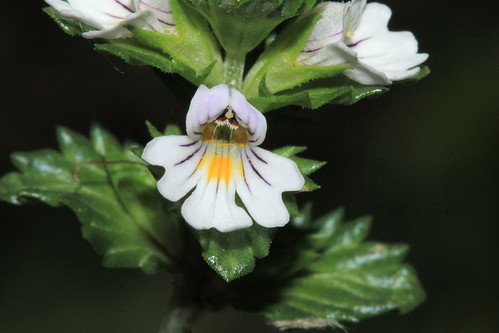The Common Eyebright Euphrasia officinalis agg
The tiny flowers of eyebright measure 8-13 mm. in length and possess beautifully intricate coloring and detail. This bilaterally symmetrical bloom has a fused corolla that opens into two lips: a small two-lobed upper lip and a larger lower lip that is divided into three palmately divided, notched lobes. Overall, the bloom is pale lavender or white. Each lobe has three dark-purple veins and the central lobe of the lower lip has a prominent, bright yellow honey spot. Bracts are green and surround the base of each flower.
Fruit:
Eyebright produces a small, capsule-like fruit.
Leaves:
The leaves of this plant are very small, measuring 6-20 mm. in length, slender, coarsely toothed, have brown tips, and are densely arranged along the length of the stem and throughout the flower cluster.
Habitat:
Eyebright grows best around fields and along roadsides.
A small flower of about The genus Euphrasia is taxonomically complicated due to many species being interfertile and prone to hybridisation.A group of small, hemiparasitic annuals on the roots of diverse herbs and small shrubs, mainly found in permanent or semi-permanent grasslands
They are semi-parasitic on grasses and other plants. The common name refers to the plant's use in treating eye infections.
Eyebright has been divided into a large number of microspecies and their hybrids,. The flowers are usually white with a yellow throat borne in a spike. Leaves are opposite and toothed.


No comments :
Post a Comment